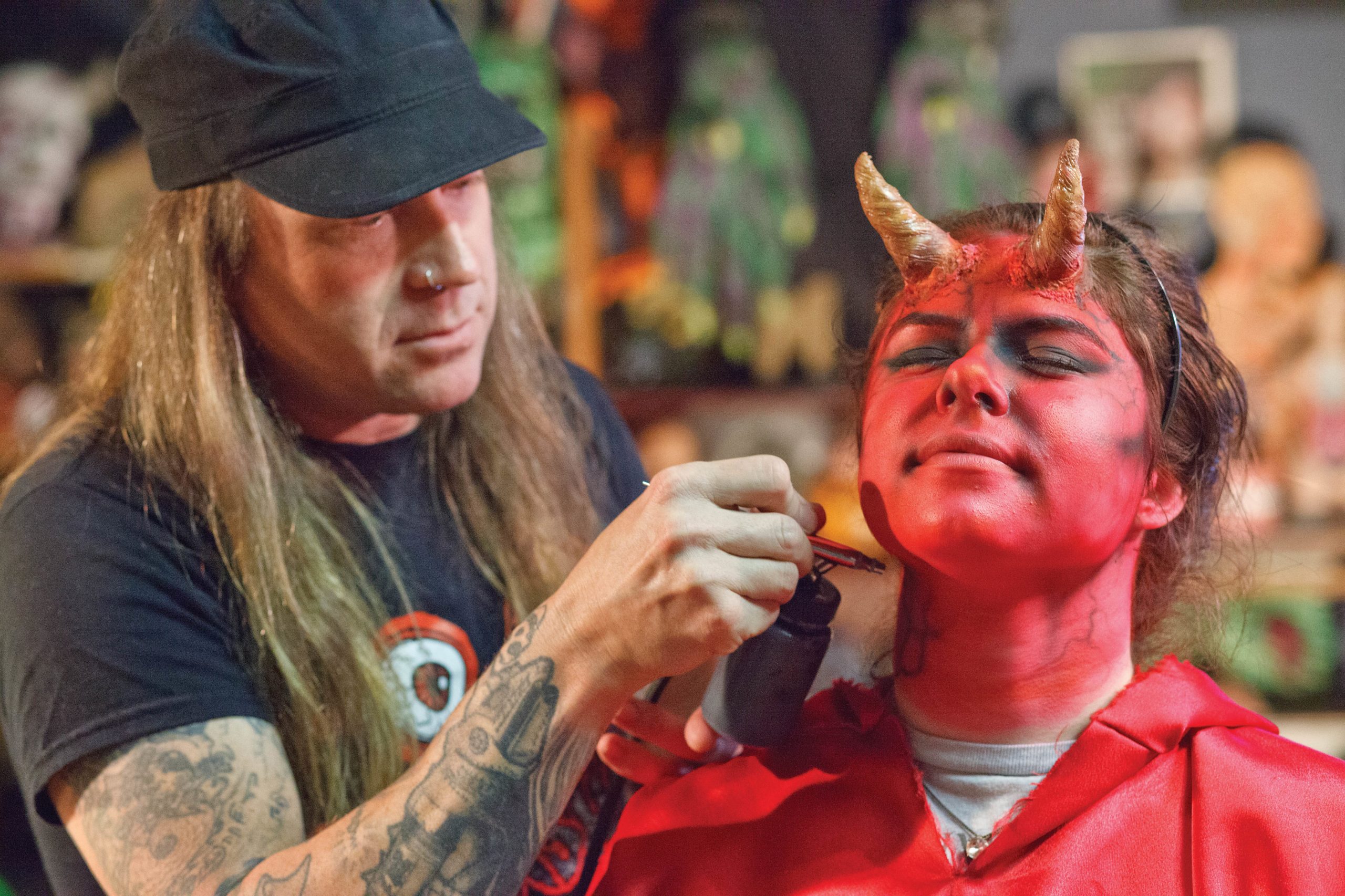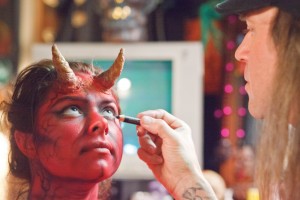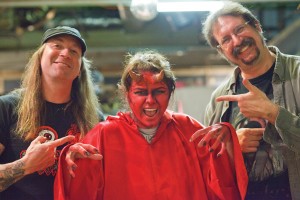
Rotting corpses, bloody bones and walls of heads greeted me at the door of Atlanta Zombie Apocalypse, a veritable hell of chaos. My eyes skirted around a huge, dimly-lit room plastered from floor to ceiling in horror movie posters and monster costumes. My first thought: Was I ready to become one of them?

I was here to interview Shane Morton and Chris Brown, the creative minds behind Adult Swim’s newest show: “Your Pretty Face is Going to Hell,” an office comedy where degenerates go to work with Satan as their boss (Thursdays at midnight). But soon after entering this kooky warehouse filled with paraphernalia of the weird, I knew this experience was going to be more than what I had imagined.
Atlanta Zombie Apocalypse, held every October, is housed here, and the grounds span over 40,000 feet to accommodate the hellish manslaughter of zombie assault.
“There are piles of dead bodies back here…” Morton said, as he led us around a huge room that was part studio, part storage room.
Remnants of set designs from Pretty Face laid about the room, including the backdrop in Satan’s office: a painted mural of Satan smacking a nude woman’s behind, looking devious as…well, Lucifer himself. Morton showed us the “Ed Wood graveyard” – based on the early low-budget horror filmmaker’s work – complete with smoke machine. A creepy pseudo-bathroom stood in the center of a room, reminiscent of a torture chamber worthy of “Saw”. A wall of melting heads stood alone, gummy faces frozen screams of eternal pain.
Morton and Brown make sets like those for a living. Their newest work appears in Your Pretty Face is Going to Hell, where Morton was art director and Brown was co-designer, and both did special FX makeup for actors on the show.
“Every time we did some crazy gag on Pretty Face where like, someone is getting their face blown off, or an infected leg spurting out tapioca pudding, everybody would just get this kind of gleeful ‘oh, this is so good’,” Morton said. “That first day we had the spurting leg…lots of pus. It was like the Neapolitan of wounds. It started with blood and then the blood turned black and then pus started shooting out and we put air bubbles in it so it would like, fart out this nasty stuff – it was just so gross. But while you’re doing that stuff it’s not really gross, it’s funny. You know, we’re all laughing and stuff.”
Tapioca pudding? The team even uses corn syrup for blood. As it turns out, food products are a regular staple in the world of SPFX. Blood is ketchup, pudding is guts, poop is…chocolate brownies. Morton squeezed his fists together to make “colons.”
“I teach classes out here and I tell people all the time that silicone is like the industry standard now, but gelatin is kind of like that. And you can just buy it at Kroger and mix it right up and make seamless wounds,” Morton said.
Morton showed us to a table with props from the show. Each actor had their own special set of horns that was created to fit their personality. There were also cell phones, “soul contracts” and computers that looked as if they were made from actual skin. I asked Morton how long it took to make a computer out of “skin”.
They bring lots of prosthetic pieces on set. Sometimes the creative duo has to come up with things on the spot and just make it work. The computers they made, which doubled as puppets, were completed in two hours, made with prosthetic pieces and hot glue, and then airbrush painted.
“I paint this [a mask] with a couple different things, first I’ll dry brush it here and then I’ll come through and airbrush it,” Morton said. “So this thing gets pretty much painted how we’re going to paint you.”
Without further ado, it was time for me to suit up and begin my transformation into a demon. Morton handed me a long, shiny red robe that I slipped over my head. As soon as I sat down, Brown and Morton were already trying to fit horns onto my head…

Morton explained how the makeup he and Brown were using on me was water-based, so it would remove easily. They picked some small horns for my “tiny” forehead and got out the spirit gum, an “easy-off” glue that has been used since the twenties.
On the set of Pretty Face, the team used Prozade, a very strong adhesive that is more resistant than spirit gum to actors’ sweat and several hours of screen time.
Morton and Brown applied spirit gum to the horns and blow dried them onto my forehead to make them stick in a process that took several minutes to complete.
While they worked on my face, the duo described their projects. Morton has worked with Rob Zombie, designed themed restaurants and haunted houses, and acts in self-produced horror shows like Silver Screen Spook Show. Brown built characters for companies like Disney-Pixar, was the head puppet-builder at the Center for Puppetry Arts in Atlanta, and has worked on several productions and puppet slams.
In addition to all their accomplishments, the two currently produce material and design for Atlanta Zombie Apocalypse, a yearly Atlanta phenomenon that is not your average haunted house. Former arts and living Signal editor CC Stovall “survived” last year’s apocalypse, saving both her own ass and a few zombie-killing tricks.
“I have been into this stuff since I was like 3 years old,” said Shane of his work. “My parents took me to see King Kong and it like really warped me. So I’ve been messing around with makeup since I was really small.”
An obsession with the creation of horror resulted, and Morton learned how to make a career in the business.
“When I was in art school in Savannah, I ended up getting a job in the art department on Return of Swamp Thing,” Morton continued. “I was only like 19. It was really awesome, but I saw how much waste went on. And it wasn’t even a big budget movie, but it kind of freaked me out.”
Morton and Brown are the self-proclaimed “kings of upcycling.”
“To me, low-budget is always better,” Morton said. “If you don’t have money, you have to think and be creative.”
Brown said that anything could happen on set. Costume and makeup malfunctions are a regular occurrence.
“You have to prepare for everything,” Brown said. “Basically you have to bring your shop with you. If you’re lucky, you’ll just need what you’ve got. But it’s very likely that you’re going to get surprised. Can you pull this out of your ass at the last moment?”
Time crunches and bizarre locations are among the challenges the creative team faces on set. Morton explained that there were 60 different locations on Pretty Face, one of which was a mountain. All the equipment had to be taken down into a ravine.
“We had to do makeup changes on the side of the mountain. Power was tough, and it was really hot, and there were copperheads everywhere and poison ivy. We came out unscathed, and everybody had a good time, but you’re looking out for all these guys who are in this uncomfortable makeup,” Morton said.
Most other sets on the show are standard. Morton said that most of the footage for hell was shot with a green screen. Sometimes he and Brown only have to build parts of a set, and the rest of the work is handled by a visual FX team.
“There was so much stuff that they were able to do with the VFX that you could never do practically,” Morton said. “Hell really looks hot. When you’re in there, there are heat lines coming off of stuff.”
Office equipment on the show looks like it’s melting. The effect was achieved by blasting everything with a flame-thrower. VFX then added “fire” to the props to make them look like they are still burning.
After several minutes of blow dryer-forehead action, my horns were securely applied. Then it was time for paint. Shane began with my face. He airbrushed my entire face, neck and hands with red makeup.
Shane said I lucked out with the makeup they were using. For the characters of Pretty Face, including lead character Gary (played by Henry Zebrowski), Shane and Chris used 99 percent alcohol makeup. This makeup tends to make people sweat much more than usual. Chris explained that the body tries to shed the makeup in an attempt to cool down.
With actors sweating, there were constant touch-ups between takes.
“This is something you’d have to get used to if you were one of our characters,” Chris said. “You constantly have people prodding and touching you and looking at you.”
I was almost demonized. I outstretched my hands as Morton painted the tops of them. For added emphasis, and because makeup lines form as I squinted my eyes, the team filled in any gaps with a grease pencil.
I rose up from my chair. Everyone in the room looked giddy, holding a secret I wasn’t yet privy to.
“You’re ready for the Black Sabbath reunion,” Morton said.
I walked over to the mirror. A cocktail of emotions took over me: excitement, astonishment and horror rushed in as I saw my reflection. From head-to-toe, I was no longer Samantha, a reporter here for an interview. Rather, I had undergone a Kafka-esque transformation: I didn’t just look like a demon – I felt like a demon. I felt evil. And in those few moments, maybe I was.
